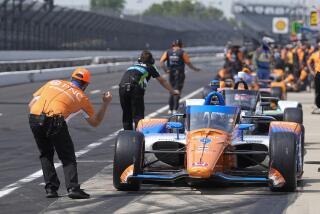Is Cooperation the Right Approach to Fuel the U.S. Car Idea?
- Share via
If U.S. Car--the proposed government-cum-Big Three auto research and development consortium--was an actual automobile, would it really be a better idea? A high-tech heartbeat of America? Or would it be unsafe at any speed?
Certainly, U.S. Car is designed to build expectations, if not excitement. The Clinton Administration has compared the initiative--designed to triple fuel efficiency within a decade--to the Manhattan Project, which produced the atomic bomb, and the Apollo program, which put a man on the moon.
What’s more, the White House heralds U.S. Car as a prototype for the sort of collaborative partnership it wants to encourage between industry and government. U.S. Car wants to be the car company that lets the top technical brains in Detroit and the vast federal research infrastructure cooperate to invent the future.
“I think that everybody will be surprised by it,” said John McTague, Ford Motor Co.’s vice president of technical affairs, who served in the White House science office during the Bush Administration. “It’s extremely revolutionary in the point of view that we’re going to approach all of this stuff together. . . . The traditional attitude has been nobody didn’t trust nobody.”
“We’re trying to stimulate new thought and new ideas with the automobile companies in a new organizational structure,” said Mary Good, the assistant commerce secretary who oversees U.S. Car. “We’re not spending any new taxpayer money on this. We’re cooperating with industry to make existing research efforts more focused.”
But is U.S. Car really the best vehicle to accelerate automobile innovation? Critics complain that it amounts to little more than a heavy-handed government attempt to impose an industrial policy agenda on the automobile industry. The best way to enhance innovation, they insist, would be to let market forces work their magic.
On one level, that’s absolutely true: U.S. Car is an unambiguous example of industrial policy. But that criticism ignores a very compelling reality: There is an awful lot of excellent, relevant technology and expertise--all supported by tax dollars--throughout various government agencies and institutions. What are we supposed to do? Ignore it? Treat this resource as if it had zero value in the marketplace?
The same people who think nothing of selling national forests to loggers, miners and developers for the sake of economic development scream “Industrial policy!” if the government tries to figure out a way to transform its holdings in research and development into engines of economic growth. Trees, yes; intellectual property, no. Where’s the consistency in that? Trying to establish economic value for an asset is at the very heart of markets.
The real difficulty with U.S. Car isn’t that the government wants to bring federal technologies to the taxpayers who pay for them, but that it is designed around a flawed economic assumption.
Perhaps it’s because President Clinton and science adviser John Gibbons (a major force behind U.S. Car) are natural consensus builders. They apparently believe that cooperation--rather than economic rivalry--is at the core of innovation. Evidently, this Administration would rather use its resources to create collaborative consortia instead of as leverage to promote competition between market rivals.
The truth is, a U.S. Car is designed less to encourage entrepreneurship than to reinvigorate troubled giants. Remember, it was foreign competition, not industrial cooperation, that got Detroit to finally take quality seriously.
So will taxpayers ultimately get more bang for their buck if government subsidizes greater industry cooperation or encourages greater industrial rivalry?
“That’s a legitimate question,” said Good of the Commerce Department. “My view is you’re going to add to competitiveness by funding consortia. If we structure things correctly, we’ll do just that and make everyone nervous. . . . If one of those guys is not innovative enough to take advantage of the research, he’ll be left behind.”
“I would be deeply skeptical of this as an appropriate policy, for many reasons,” said Harvard Business School Prof. Michael Porter, who has done extensive research on industrial competitiveness and economic rivalry. “The critical reason is that the history of international competition does not produce many examples where this kind of collaborative activity--particularly in the context of technical innovation--has produced genuine, sustained innovation.”
Porter is something of a technological Keynesian. He believes government should look less to building new technologies than to guaranteeing some sort of market for them.
“I would say that the optimum model for government is to act on the demand side, not the supply side,” he said. Government, Porter says, ought to guarantee that there is a winner-- any winner--of the race, to eliminate some of the uncertainties associated with innovation. For example, a consortium of utilities recently announced that they would purchase up to $500 million in solar panels over the next six years, thus guaranteeing a market for innovative solar technology.
To Good’s credit, she acknowledged that U.S. Car represents a risk--but a risk worth taking, given the importance of the automobile industry and the value of fostering a new partnership with the industry. In reality, U.S. Car is more of an experiment than a model for public policy.
The real tests will be to see if U.S. Car has the courage to make public its timetable for reaching important technical milestones on the road to achieving triple fuel efficiency in an environmentally sound manner--and whether the Clinton Administration and Mary Good have the courage to hit the brakes if U.S. Car can’t reach these goals.
The ultimate test, however, will be whether consortia founded and funded on the principle of cooperation are better at driving innovation than market-driven competition.






